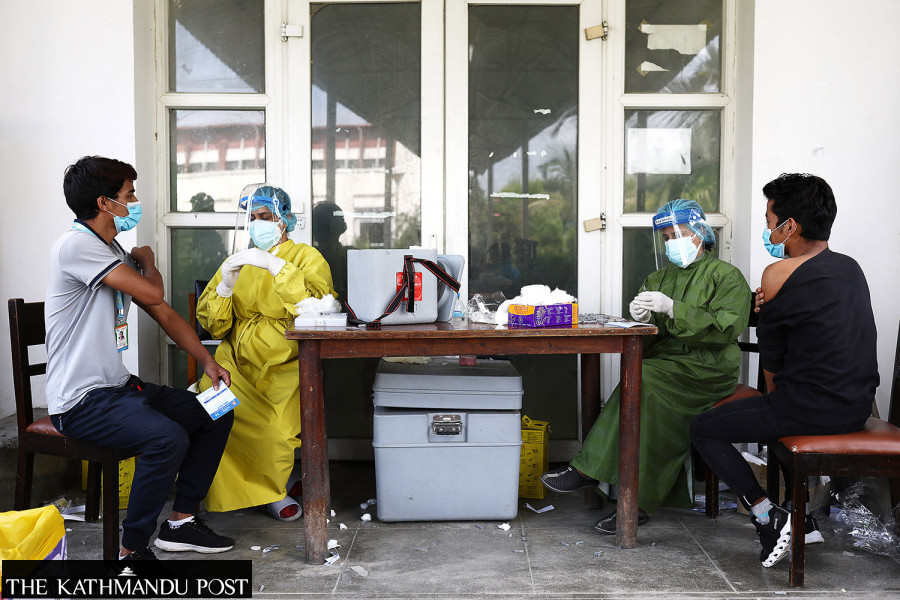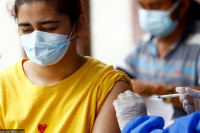Health
Government failure to estimate actual population size hits Covid vaccination programme
Experts say real-time data on population size is crucial for formulating plans and policies and for their success.
Arjun Poudel
The Ministry of Health and Population decided to start the Covid immunisation drive for children between five and 11 years in two phases.
Officials estimated there are around 2.2 million children of the said age group in the 27 districts, where the first phase of the campaign was launched on June 23.
The Health Ministry uses the approximation projected by the Central Bureau of Statistics to estimate the target population, in this case, for immunisation against Covid-19. For the vaccination of children between five and 11 years, the ministry based its estimation of the required number of doses on the preliminary data of the National Census 2021 released by the Bureau.
The actual data could therefore differ leading to a wrong estimation, experts say, for not just Covid vaccination programmes but also for other health care programmes.
In the vaccination drive for children between five and 11 years, the estimation proved to be inaccurate which led to many districts putting the vaccination drive on hold due to vaccine crunch. This indicated that the number of children between five and 11 years was more than the government’s estimate.
“The mismatch in government figures is not unique to this vaccination drive. There are several instances where estimation of the target group did not match the exact number of children of the said age group,” said Shree Krishna Bhatta, a public health expert who is also a former president of the Nepal Public Health Association. “In many districts, including those in the Kathmandu Valley, coverage of the programmes generally exceeds the given targets.”
Officials said that projections of the population size are made on the basis of births, deaths and migration rate.
According to preliminary data of the National Census 2021, Nepal’s population stands at 29,192,480.
But surveys carried out after campaigns show significant dropout numbers or those who missed the programme. Surveys had shown that some children, including those in Kathmandu Valley, have not taken even a single dose of the Covid vaccine.
The first phase of the vaccination campaign for children between five and 11 years started on June 23 for a week but within a few days of the campaign’s launch, several districts had started to report a shortage of vaccine doses and halted the campaign before its deadline.
“This happens when our population estimates do not match with the exact population size,” said Bhatta, the public health expert. “This is a serious issue. It not only affects the coverage of the Covid vaccination programmes but also poses impediments to achieving the goals of all other public health programmes.”
Experts say real-time data on population size is crucial for formulating plans and policies and for their success.
The Covid vaccination for children between five and 11 years resumed after the Health Ministry supplied more vaccine doses to the districts. But the failure to make a proper estimation of the population has been affecting many other public health programmes. It also hinders the implementation of other government campaigns such as educational programmes, drinking water supply plans, and the setting up of government offices to provide services; electricity services, and even banking services, among others, experts say.
To have the ground data on the population, it is important to keep track of internal migration but officials at the Health Ministry said that no one really knows the size of floating populations, especially in the Kathmandu Valley. There are no agencies or government bodies that keep a record of internal migration in Nepal.
“No one knows the exact number of floating population,” said Anil Thapa, an official at Integrated Health Information Management System under the Department of Health Services.
Thapa said that his office has updated the population size as per the preliminary data released by the Central Bureau of Statistics.
However, when a family moves from their native district to another, their migration record is updated neither in their native district nor in the district where they have migrated to.
“And the chances of such a population missing out on government programmes increases,” said Dr Sarad Onta, a public health expert. “The district, where the migrant population resides does not include the newcomers in its own population, and the district, from where they migrated, consider them outsiders since they no longer live in that district.”
Migration—both internal and external—has increased significantly of late pushed by the desire for better education, health care services, benefits, and opportunities. Experts say that migration not only affects the population size of particular places, especially urban areas, but also has a manifold impact on all other sectors including public healthcare.
“Had we made our record-keeping system effective, we would not have any problems in estimating the target population and the coverage of the Covid vaccination programmes,” said Onta. “There would be no confusion if we had a sound data-keeping system.”
Proper record-keeping has always been problematic in Nepal’s health care sector and public health experts had, since the start of the vaccination, stressed the need for robust record-keeping.
It has been learnt that the health authorities do not have a proper record of Covid vaccine doses supplied to the districts. As a result, hundreds of thousands of doses are still unaccounted for.
“Record keeping of births, deaths and migration is the basic duty of the authorities concerned,” said Onta. “It must be done for the planning of any programme, whether it is of health care, drinking water, electricity supply or others. We cannot achieve the targets if our estimations are unreliable.”




 10.12°C Kathmandu
10.12°C Kathmandu














